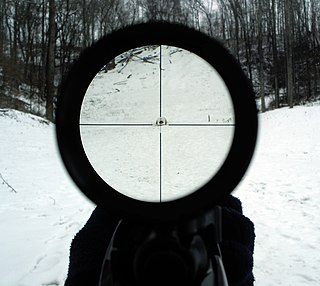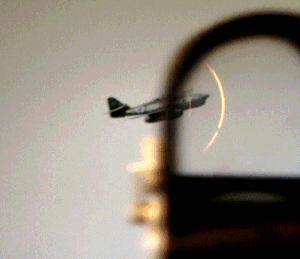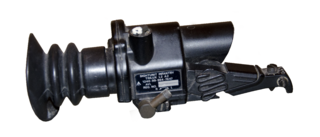
Night vision is the ability to see in low-light conditions, either naturally with scotopic vision or through a night-vision device. Night vision requires both sufficient spectral range and sufficient intensity range. Humans have poor night vision compared to many animals such as cats, dogs, foxes and rabbits, in part because the human eye lacks a tapetum lucidum, tissue behind the retina that reflects light back through the retina thus increasing the light available to the photoreceptors.

The Advanced Combat Optical Gunsight (ACOG) is a series of prismatic telescopic sights manufactured by Trijicon. The ACOG was originally designed to be used on the M16 rifle and M4 carbine, but Trijicon has also developed ACOG accessories for other firearms. Models provide fixed-power magnification levels from 1.25× to 6×. ACOG reticles are illuminated at night by an internal tritium phosphor. Some versions have an additional daytime reticle illumination via a passive external fiberoptic light pipe or are LED-illuminated using a dry battery. The first ACOG model, known as the TA01, was released in 1987.

A telescopic sight, commonly called a scope informally, is an optical sighting device based on a refracting telescope. It is equipped with some form of a referencing pattern – known as a reticle – mounted in a focally appropriate position in its optical system to provide an accurate point of aim. Telescopic sights are used with all types of systems that require magnification in addition to reliable visual aiming, as opposed to non-magnifying iron sights, reflector (reflex) sights, holographic sights or laser sights, and are most commonly found on long-barrel firearms, particularly rifles, usually via a scope mount. Similar devices are also found on other platforms such as artillery, tanks and even aircraft. The optical components may be combined with optoelectronics to add night vision or smart device features.
The eye relief of an optical instrument is the distance from the last surface of an eyepiece within which the user's eye can obtain the full viewing angle. If a viewer's eye is outside this distance, a reduced field of view will be obtained. The calculation of eye relief is complex, though generally, the higher the magnification and the larger the intended field of view, the shorter the eye relief.

The Sight Unit Small Arms, Trilux, or SUSAT, is a 4× telescopic sight, with tritium-powered illumination utilised at dusk or dawn. The full name of the current model is the SUSAT L9A1. The sight is not designed as a sniper sight, but is rather intended to be mounted on a variety of rifles and to be used by all infantrymen.

A milliradian is an SI derived unit for angular measurement which is defined as a thousandth of a radian (0.001 radian). Milliradians are used in adjustment of firearm sights by adjusting the angle of the sight compared to the barrel. Milliradians are also used for comparing shot groupings, or to compare the difficulty of hitting different sized shooting targets at different distances. When using a scope with both mrad adjustment and a reticle with mrad markings, the shooter can use the reticle as a ruler to count the number of mrads a shot was off-target, which directly translates to the sight adjustment needed to hit the target with a follow-up shot. Optics with mrad markings in the reticle can also be used to make a range estimation of a known size target, or vice versa, to determine a target size if the distance is known, a practice called "milling".

Raytheon ELCAN Optical Technologies, also simply ELCAN, is a Canadian optics and electronics manufacturing company owned by American defense contractor RTX Corporation, currently based in Midland, Ontario. ELCAN produces optical devices geared towards both civilian and military markets, and their products are sold through Armament Technology Inc. based in Halifax, Nova Scotia, and associated channels of dealers.
The Special Operations Peculiar MODification (SOPMOD) kit is an accessory system for the M4A1 carbine, CQBR, FN SCAR Mk 16/17, HK416 and other weapons used by United States Special Operations Command (USSOCOM) special forces units, though it is not specific to SOCOM. The kit allows US Special Operations Forces personnel to configure their weapons to individual preferences and customize for different mission requirements.

The C79 optical sight (SpecterOS3.4x) is a telescopic sight manufactured by Elcan. A variant, the M145 Machine Gun Optic is in use by the US military. It is 3.4×28, meaning 3.4x magnification, and a 28mm diameter objective lens. A tritium illuminated reticle provides for normal and low-light conditions sighting. It can be mounted to a variety of rifles and light machine guns using the Picatinny rail mounting system or the similar Diemaco rail system found on small arms produced by Diemaco/Colt Canada. Similar rifle sights are the Sight Unit Small Arms, Trilux (SUSAT) and the Advanced Combat Optical Gunsight (ACOG).

The PSO-1 is a 4×24 telescopic sight manufactured in Russia by the Novosibirsk instrument-making factory and issued with the Russian military Dragunov sniper rifle. It was introduced on 3 July 1963 together with the Dragunov sniper rifle.

AN/PVS-4 is the U.S. military designation for a specification of the first second generation passive Night vision device.

A red dot sight is a common classification for a non-magnifying reflector sight that provides an illuminated red dot to the user as a point of aim. A standard design uses a red light-emitting diode (LED) at the focus of collimating optics, which generates a dot-style illuminated reticle that stays in alignment with the firearm the sight is attached to, regardless of eye position.

A reflector sight or reflex sight is an optical sight that allows the user to look through a partially reflecting glass element and see an illuminated projection of an aiming point or some other image superimposed on the field of view. These sights work on the simple optical principle that anything at the focus of a lens or curved mirror will appear to be sitting in front of the viewer at infinity. Reflector sights employ some form of "reflector" to allow the viewer to see the infinity image and the field of view at the same time, either by bouncing the image created by lens off a slanted glass plate, or by using a mostly clear curved glass reflector that images the reticle while the viewer looks through the reflector. Since the reticle is at infinity, it stays in alignment with the device to which the sight is attached regardless of the viewer's eye position, removing most of the parallax and other sighting errors found in simple sighting devices.

The PU scope is a 3.5×21 telescopic sight of Soviet manufacture, widely used since 1940 on the SVT-40 rifle for which it was originally designed and since 1942 on the Mosin–Nagant rifle. Before converting the PU for Mosin–Nagant Model 1891/30 sniper rifles these rifles used 3.87×30 PE(M) telescopic sights, a Soviet-made copy of a German Zeiss design, while later rifles used smaller, simpler, and easier-to-produce 3.5×21 PU telescopic sights. The PU telescopic sight has a fixed at 3.5 power magnification. The reticle could be adjusted vertically for range, and the elevation turret is graduated from 0–1,300 m (0–1,422 yd) in 100 m (109 yd) increments. The bullet drop compensation (BDC) adjustment in the elevation turret is free spinning under grease friction. The windage adjustment turret of the telescopic sight features more conventional click adjustments in milliradian increments. The design turned out to be so successful and in demand that production was not stopped after World War II and the sight was converted for and used on other small arms.
The PSL is a Romanian designated marksman rifle. It is also called PSL-54C, Romak III, FPK and SSG-97. Though similar in appearance, mission and specifications to the SVD Dragunov, the PSL rifle is mechanically completely different as it is based on the RPK light machinegun, with its internals simply being scaled up to accommodate the more powerful 7.62×54mmR cartridge.

The SUIT sight is a 4× prism sight with tritium-powered illumination, utilised at dusk or dawn. The full name is the L2A2 Sight Unit Infantry Trilux. The sight is not designed as a sniper sight, but as a standard issue infantry sight to improve the infantryman's night fighting capability and to assist target identification at long range in daylight and in poor light conditions.
1PN51-2 is the GRAU index for a Soviet designed passive night scope for the RPG-29 rocket launcher. 1PN is the GRAU index of night vision devices, where PN stands for Nochnoy Pritsel meaning night sight.

USP-1 or "Tyulpan" is a Soviet/Russian universal optic sight, used on the AK rifle family, the RPK-74N, the PKMN and the PKP "Pecheneg" and is designed for quick-mounting and quick-detaching. Compared with an open mechanical sight, the effectiveness of firing at targets is increased 1.2 to 2 times, and the time taken to conduct a firing session is reduced by 60%. It was designed by the Royal Armaments Research Development Establishment (RARDE) in the United Kingdom in the early 1970s; the design was stolen by the USSR, and new elevation cams ballistically matched to Soviet weapons were developed to replace the original British cam matched to the L1A1 Self-Loading Rifle. Production is conducted in Novosibirsk instrument manufacturing factory (NPZ).

1P78 is a telescopic sight manufactured by Novosibirsk Instrument-Making Plant and in use with the Russian Armed Forces, intended as a replacement for the older PSO-1 and 1P29 scopes currently being used by the Russian military. The optic is intended to become the standard issue sight for the infantry riflemen within the Russian military.

A prism sight or prismatic sight, sometimes also called prism scope or prismatic scope, is a type of telescopic sight which uses a reflective prism for its image-erecting system, instead of the series of relay lenses found in traditional telescopic sights. The use of prisms makes it possible to construct a shorter and lighter sight, or with an offset between the eyepiece and objective axes, although restricting the achievable range of magnification.

















